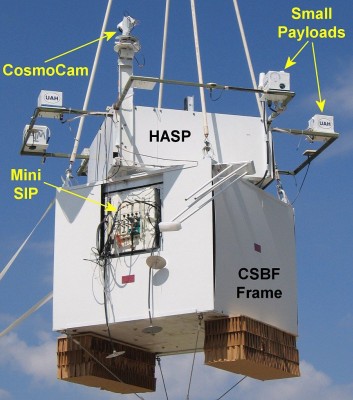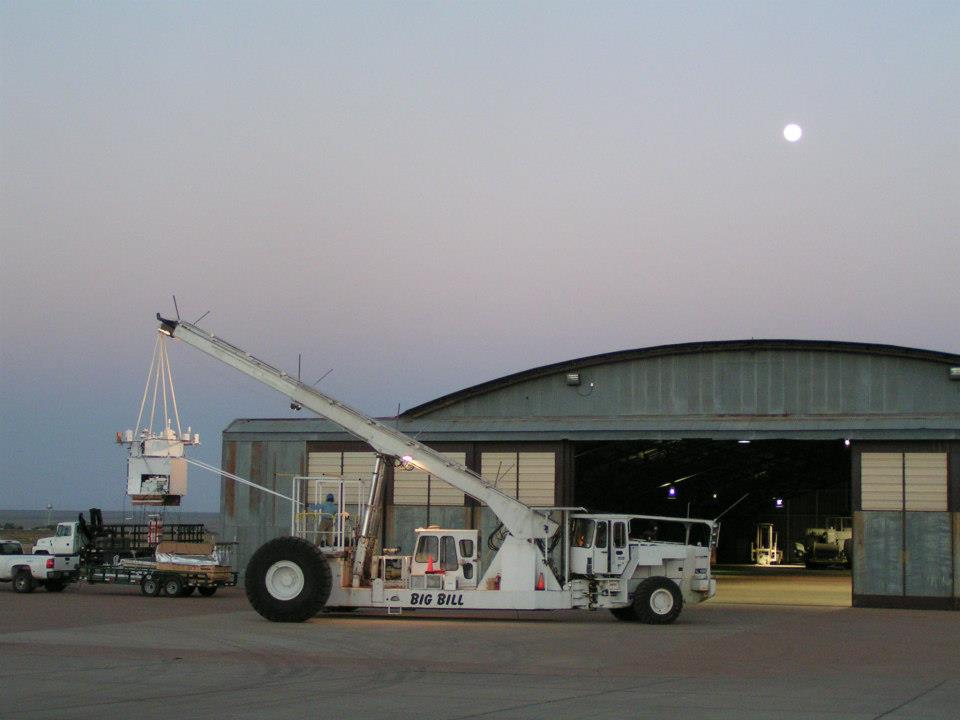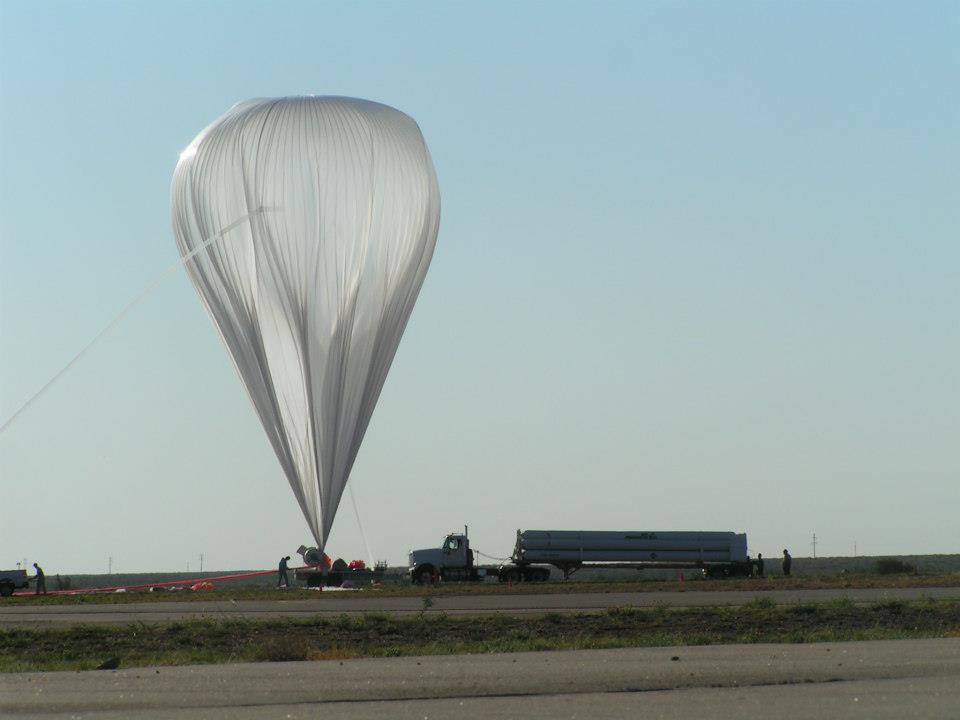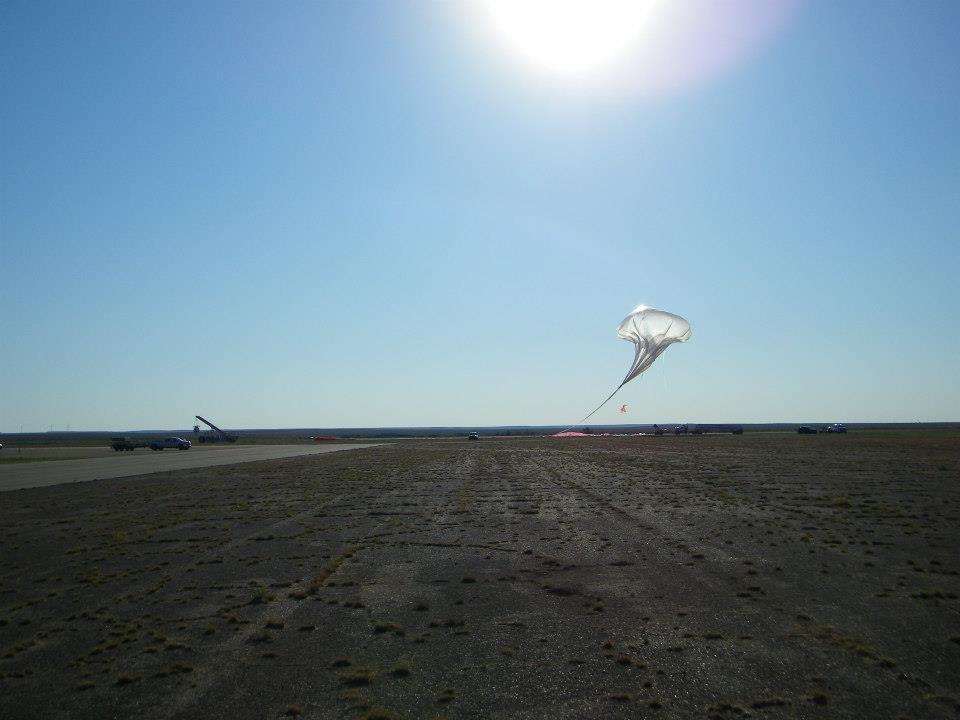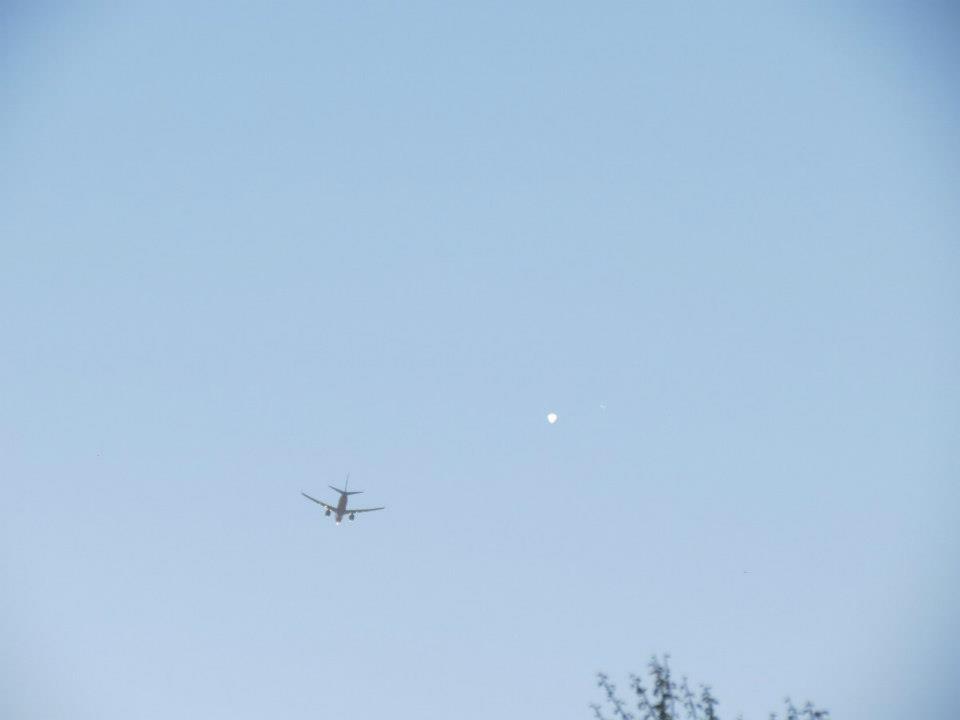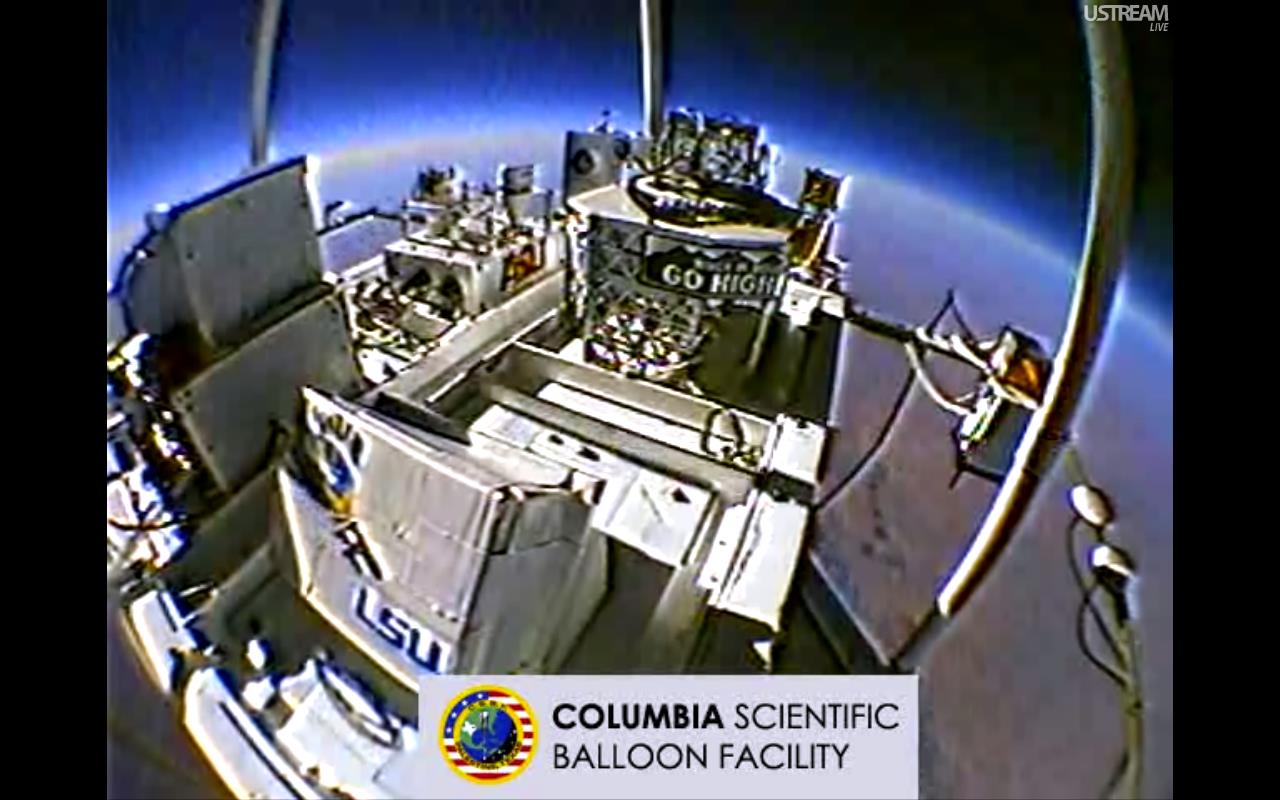Purpose of the flight and payload description
HASP stands for High Altitude Student Platform and is a program aimed to foster student excitement in an aerospace career path and to help address workforce development issues in this area. In the framework of the program a multi-instrumented platform was designed to carry up to twelve student payloads to an altitude of about 36 kilometers with flight durations of 15 to 20 hours using a small volume, zero pressure balloon. The payloads carried by HASP are designed and built by students and are used to flight-test compact satellites or prototypes and to fly other small experiments. The state of Louisiana and the Louisiana Space Consortium have funded the construction and operation of HASP and the Columbia Scientific Balloon Facility (CSBF) through the NASA Balloon Program Office has committed to flying HASP once a year for three years.
At left can be seen an image of the entire HASP flight configuration payload which is composed of two major components; the CSBF frame on the bottom and the HASP system on the top. The CSBF frame is the primary structural element of the payload and was recycled from an older test payload frame by the CSBF. This component houses all the subsystems CSBF requires to monitor and control the balloon vehicle. On the top corners of this frame are the attachment points for cabling leading to the swivel, flight train, parachute and balloon. Each suspension cable is threaded through a PVC pipe increasing the rigidity of the suspension system and reducing the probability that, upon landing, the swivel would impact student payloads located on the top of HASP. On the bottom of the CSBF frame is the cardboard honeycomb crush pad and attach points for the ballast hopper suspension cables.
The interior of the frame supports a Mini-SIP (Support Instrument Package) that interfaces to the HASP electronics and provides uplink-downlink communication with the balloon payload, with empty room for a variety of prototypes and test articles, allowing the CSBF to test fly new technology that may improve the performance of future professional scientific balloon systems.
Attached to the core structural frame are four fiberglass frames that support the small (< 1 kg) student payloads. Each brace
extends 56 cm away from the aluminum frame and supports two student payload mounting plates, each of which includes standard mechanical, power and serial communication interfaces. One such brace is attached to each side of the core structure to accommodate up to eight student payloads. This configuration was chosen to minimize interference between the metal frame and any student payloads that may exercise their transmitters during flight. In addition, up to four large (< 10 kg) student payloads can be mounted on the top of the core structure and have a power and communication interface similar to that of the small payloads.
The command and control subsystem, provides the means for receiving and processing uplinked commands, acquiring and archiving the payload data, downlinking status information and interfacing with the student payloads. There are three primary control modules in the subsystem that communicate with each other over a 100 Mbps (megabit per second) internal Ethernet network. These modules are the Flight Control Unit (FCU) which "manages" the subsystem; decoding commands received from the CSBF supplied Mini-SIP and distributing them, watching for units that may need to be reset, collecting status information and downlinking data through the Mini-SIP. In addition, the FCU also monitors the voltages and currents of the power system and collects environmental temperature information for housekeeping records.
The Data Archive Unit (DAU) that controls the on-board recording of all data, making these data records available to other processes on the network, controlling the HASP GPS receiver and managing the time-stamping of all records. All on-board recording is to Compact Flash cards which appear as hard disks to the operating system, but function well in hard vacuum. The Serial Communications Unit (SCU) runs the software which communicates with the student payloads. Without this unit, student data will not be collected.
Finally, temperature sensors are placed at strategic locations around HASP (e.g. batteries, solar shield panels, exterior) to monitor the environment and assess the thermal performance of the system. The input power source for HASP is about 30 VDC and is provided by either a Lambda ZUP36-24 for ground operations or eight B7901-11 eleven cell lithium sulphur dioxide batteries for flight.
One of the major innovations incorporated into HASP was to mount all the command and control components on a single 109 cm x 36 cm Electronics Mounting Plate (EMP). This has the primary advantage that the EMP can be easily removed from the HASP frame for easy access to all the electronics during debugging, testing and/or servicing. In addition, a complete flight spare EMP was built during HASP development and can be used as a "plug and play" replacement in the field should problems arise with the original.
Video of the launch operations
Details of the balloon flight

Balloon launched on: 9/1/2012 at 14:19 utc
Launch site: Scientific Flight Balloon Facility, Fort Sumner, (NM), US
Balloon launched by: Columbia Scientific Balloon Facility (CSBF)
Balloon manufacturer/size/composition: Zero Pressure Balloon Raven - W11.82-1E-37 - 11.820.000 cuft
Flight identification number: 632N
End of flight (L for landing time, W for last contact, otherwise termination time): 9/2/2012 at 1:17 utc
Balloon flight duration (F: time at float only, otherwise total flight time in d:days / h:hours or m:minutes - ): 11 h
Landing site: W of Phoenix, Arizona, US
The balloon was launched by dynamic method using the Big Bill launch vehicle at 14:19 utc on September 1st, 2012. The ascent to float altitude of 122.000 feet was completed at 16:28 utc, after which the balloon acquired a westward route crossing the New Mexico to Arizona where at 1:17 utc of the next day the mission was terminated.
The payload landed at 2:07 utc in a point located west of Phoenix, Arizona at coordinates 33º 45'60" N - 112º 46' 20" as can be seen in the map at left (click to enlarge).
Total flight time was 11 hours.
This was the 7th mission of the HASP program. The flight included the following experiments:
BUSAT a developmental program between Georgia Institute of Technology and New Mexico Institute for Mining and Technology intended to fly the Satellite Platform Integrated First Flight (SPIFF) aggregate instrument platform to gather baseline data on the fair-weather electric field, monitor the high-altitude magnetic field, and record changes in the structural integrity of a high-altitude scientific instrument.
High Altitude Radiation Detector (GU-HARD-PL02) developed at Gannon University aimed to investigate how the "east-west" angular asymmetry in arrivals of cosmic rays changes with altitude, as the cosmic ray flux transitions from mostly secondary particles near the ground level to mostly primary cosmic rays near balloon-float altitudes.
High Altitude X-Ray Detector Testbed an experiment developed at the University of Minnesota with the goal to test and validate the performance of a compact x-ray detector and its associated communication and data-handling computer.
Single Event Effect Detector designed at the Montana State University. As a research effort into building radiation tolerant computing systems for aerospace applications, a radiation sensor system in addition to an FPGA-based flight computer recorded radiation strikes throughout the duration of the flight.
Stratopigeon III a project of the University of Maryland. The purpose of the StratoPigeon payload was to provide science payloads with access to a full set of data during flight in addition to the data-downlink and to provide an easier method of data storage, delivery, and recovery. This was the third participation of the project in HASP.
ARIES-DYNAMICS and ARIES-GPS two payloads developed at Inter-American University of Puerto Rico, Bayamon Campus whose purpose was to increase the knowledge of aerospace engineering specialized in CubeSat technology also permitting the students to gain knowledge and experience in attitude determination and control systems of a payload and to fly and compare the performance of two different dual frequency GPS receivers.
Measurement of the ozone profile in the stratosphere using nanocrystalline and nanocomposite sensor arrays developed by a team from Universities of North Dakota and North Florida. For the verification of earlier data from HASP missions improved versions of the sensors and payload were transported. Two different groups of ozone sensor arrays: (i) nanocrystalline ITO thin film and (ii) nanocomposite ZnO-ITO and WO3-ITO gas sensors will be used for the comparison of performance of the sensors.
High Altitude Turbine Survey (HATS) a development of the University of Arizona. It consist of an attitudinal wind velocity experiment aimed at understanding thrust and other performance characteristics of four varied micro-propellers along a vertical profile (35km). Onboard sensors including optical encoders, strain gauges, thermocouples, pressure gauges, an anemometer (wind V), and digital wind vane, will provide environmental data throughout accent and decent in order to create a velocity and thrust generation profile corresponding to altitude, pressure, and wind speed.
HELIOS (Hydrogen-alpha Exploration with Long Infrared Observation Systems of The Sun by the University of Colorado; a payload aimed to observe the Sun in the Hydrogen-Alpha and Infrared wavelengths utilizing customized optics and an Attitude Determination and Control System.
Louisiana State University provided two experiments for the flight a Directional Cherenkov Detector prototype cosmic ray charge detector for the use in the Calorimetric Electron Telescope (CALET) project and Sampling Microbes In The High atmosphere (SMITH) a payload aimed to sample for biological particles in the stratosphere. The late experiment in collaboration with the Southern University. Both payloads were flown also in HASP 2011.
External references
- HASP website Louisiana Space Consortium
- HELIOS website Colorado Space Grant Consortium
11407If you consider this website interesting or useful, you can help me to keep it up and running with a small donation to cover the operational costs. Just the equivalent of the price of a cup of coffee helps a lot.

